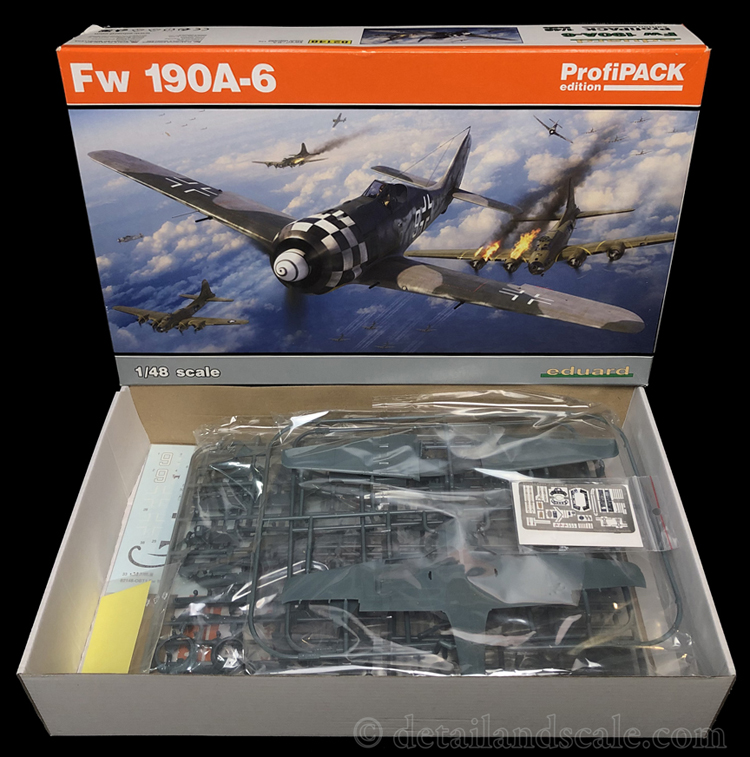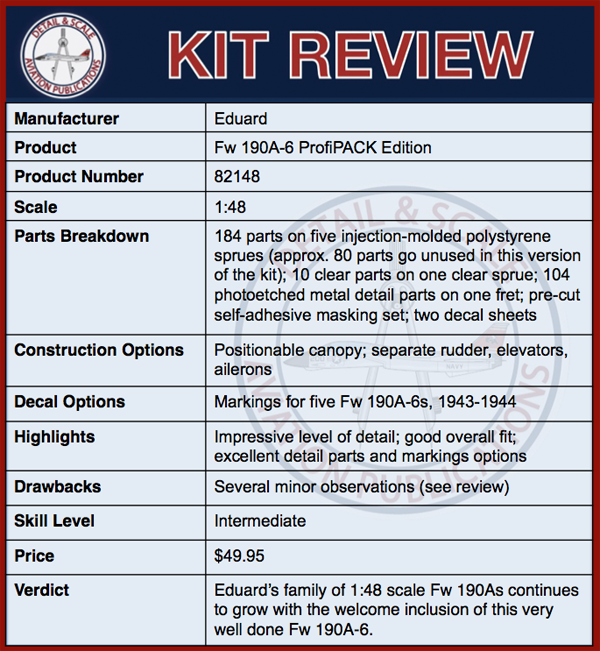Eduard Fw 190A-6 ProfiPACK Edition


The Fw 190 was, according to some, the definitive German fighter of WWII. Beginning in 2017, Eduard launched a new, re-tooled family of 1:48 scale Fw 190A kits. In 2020, the Fw 190A-6 was released, and one recently arrived on our review bench. Let’s have a look at the ProfiPACK edition of their Fw 190A-6.

In 1934, the German Ministry of Aviation (RLM) issued a call for proposal for a modern fighter design that would definitively rearm and modernize the Luftwaffe. Arado, Focke-Wulf, Heinkel, and Messerschmitt developed prototypes for a fly-off. The Messerschmitt 109 was selected in 1936 as the winning design. In 1937, the RLM saw a need for a second fighter to complement the Me 109. Focke-Wulf designers led by Kurt Tank took another look at their losing Fw 159 prototype and began to develop a range of new designs, drawing on the 159’s virtues but also transcending its weaknesses. Design studies reached maturity when they included an air-cooled, 14-cylinder BMW 139 radial engine paired with innovations that achieved a low-drag cowling which also optimized engine airflow and cooling characteristics. Other features included extensive use of electrical versus hydraulic controls, control rods (as opposed to cables) that made handling more crisp and responsive, and various airframe refinements including increased wing loading.
The first Fw 190 Würger (or Shrike) V1 flew on June 1, 1939. This marked the origin of one of the most prolific production runs of any WWII-era fighter, involving some 20,000 airplanes that spanned (by my count) 77 variants and sub-types. Many were powered by the twin-row BMW 801 radial engine. It was arguably the Luftwaffe’s most effective day fighter, serving in every corner of Europe and North Africa. It also excelled as a fighter-bomber, dedicated ground-attack platform, and night fighter.
The Fw 190A-6 emerged in July 1943 in response to the difficulties (e.g., somewhat insufficient firepower and weight) experienced by earlier Fw 190As in the air defense role. A lighter and stronger wing was developed which also carried a total of four 20 mm MG 151 wing root and outer wing cannon with larger ammunition boxes. The two MG 17 fuselage machine guns were retained. The Fw 190A-6 was also fitted with the FuG 16 ZE radio navigation system necessitating installation of a loop aerial and whip antenna on the aft lower fuselage. More than 960 Fw190A-6s were produced before the Fw 190A-7 appeared on the scene in the late Fall of 1943.

Eduard’s ProfiPack edition of their new-tool Fw 190A-6 comes on five blue-gray sprues holding a total of 185 parts (about 100 will be used; see below). Ten clear parts are on also found on one sprue. As the ProfiPACK edition of the kit, there’s also one fret holding 48 photoetched metal parts (some pre-painted) and one pre-cut self-adhesive masking set for the masking of the clear parts and wheel hubs. The decal sheets provide full airframe stencils and markings for five airplanes:
- Fw 190A-6, flown by Lt. Heinz-Günther Lück, 1./JG 1, Deelen, the Netherlands, August 1944
- Fw 190A-6, W. Nr. 550461, flown by Oblt. Helmut Radtke, 5./JG 54, Immola, Finland, Summer 1944
- Fw 190A-6, W. Nr. 550453, flown by Hptm. Friedrich-Karl Müller, Stab./JG 300, Bonn-Hangelar, Germany, October 1944
- Fw 190A-6 flown by Fw. Günther Josten, 1./JG 51, Bobruysk, Soviet Union, January 1944.
- Fw 19 A-6, W. Nr. 550473, flown by Fw. Walter Nietzsche, II./JG 300, Rheine, Germany, Summer 1943
Strengths: The new generation of 1:48 scale Eduard Würgers continues to grow, and in comprehensive fashion, further encompasses the entire family of Fw 190As. These kits addressed all the previous critiques of their first generation 1:48 scale Eduard 190s. All of the observations and accolades that apply to their previous new-issue Fw 190s (see reviews HERE) also apply here. What new in this issue of the kit? Sprue H. It contains a new set of wings representing the Fw 190A-6 variant.
Just as all their other 190As, parts breakdown and overall engineering result in a kit that is quite straightforward to build. Overall fit is excellent. Construction will not be particularly time consuming. Surface detail is outstanding as expected from Eduard, with beautifully executed and restrained recessed panel lines and elegant recessed rivet details arrayed into complex (and as best I can tell) accurate patterns.
The plastic cockpit parts by themselves are a bit simplified, but the 49 pre-painted photoetched metal parts for the instrument panel, side consoles, shoulder harnesses, and lap belts (among other detail parts) add an impressive level of detail (as it would seem Eduard intended from the get-go). Engine exhaust stacks are okay for 1:48 scale. While the exhausts themselves are not hollow as a resin casting can achieve (and there’s an Eduard Brassin set for that), the kit parts do feature slightly recessed faces and a good wash of a dark color can achieve the illusion of a deeper exhaust.
The landing gear, tires, and tailwheel assembly are all very nicely detailed and molded. The rudder, elevators, and ailerons are all separate parts. At least for the rudder, the mounting tab seems to force a straight-in fit and a little modification might be necessary to fit the rudder in a deflected position. The clear parts are gorgeous and possess pretty much perfect optical quality with no seams present. Likewise, the pre-painted photoetched parts are beautifully made. There are a lot of unused parts in this kit – about 80 in all – that apply to other Fw 190A variants.
I am a huge fan of Eduard masks, and this precision pre-cut, self-adhesive masking set will save quite a bit of time and effort masking the clear parts and wheel hubs. The decal sheets were printed in-house by Eduard and cover the five well-chosen and eye-catching schemes described above. I really like all of them, but the black-and-white checkerboard cowl seen on Lt Lück’s aircraft (and the subject of the box art) is the most impressive. Checkerboards on curved engine cowlings can be very tricky to pull off as decals, but here, Eduard quite thoughtfully split up these markings into five separate decals that go atop a painted white base color. Decal printing appears perfect. Everything is in register, colors look great, and carrier film is finely restrained. The second, smaller decal sheet contains complete maintenance stencils for the airplane. The main decal sheet appears to be of Eduard’s new style of wet transfer decals (as opposed to water slide decals). A guide to using wet transfers can be found HERE).
Weaknesses: As in the past, there is very little to critique here. Note, however, that the landing flaps are not molded as separate parts, but there’s an Eduard PE set for that. Second, I do believe the inboard main gear well doors should be closed in the parked position, as I understand that they cycled open and then closed when the gear was either retracted or extended. Third, the cockpit and gear wells are just a bit simplified. I draw this observation from a few close-up inspections of surviving Fw 190s made specifically to help evaluate these Eduard kits. So, if these simplified details bug you, there are plenty of photoetched and Brassin sets to take care of any “minimized” detail there, and almost anyone can add the appropriate wiring/plumbing in the wells with very little effort.

Once again, Eduard nails it with another great 1:48 scale kit of the Fw 190A, and their work here is an impressive representation of the Fw 190A-6. And as always, for those scale modelers interested in adding even more detail to their Fw 190A-6, Eduard manufactures a diverse range of detail sets for the cockpit, engine, machine guns, landing flaps, cannon bays, and more. Opportunities abound with this kit.
Sincere thanks are owed to everyone at Eduard for the review sample. You can visit them on the web at http://www.eduard.com and on Facebook at https://www.facebook.com/EduardCompany.
Haagen Klaus
Scale Modeling News & Reviews Editor
Detail & Scale


